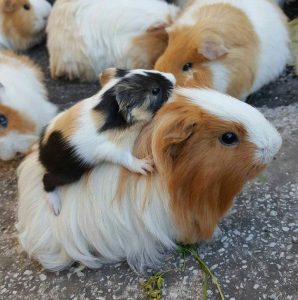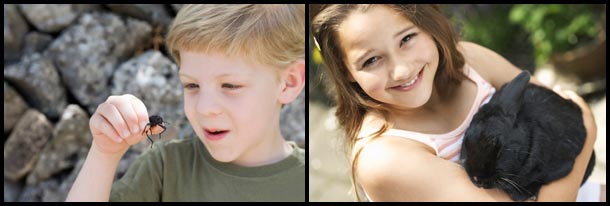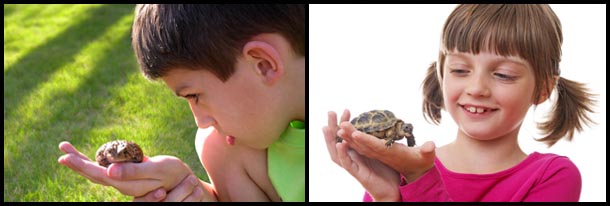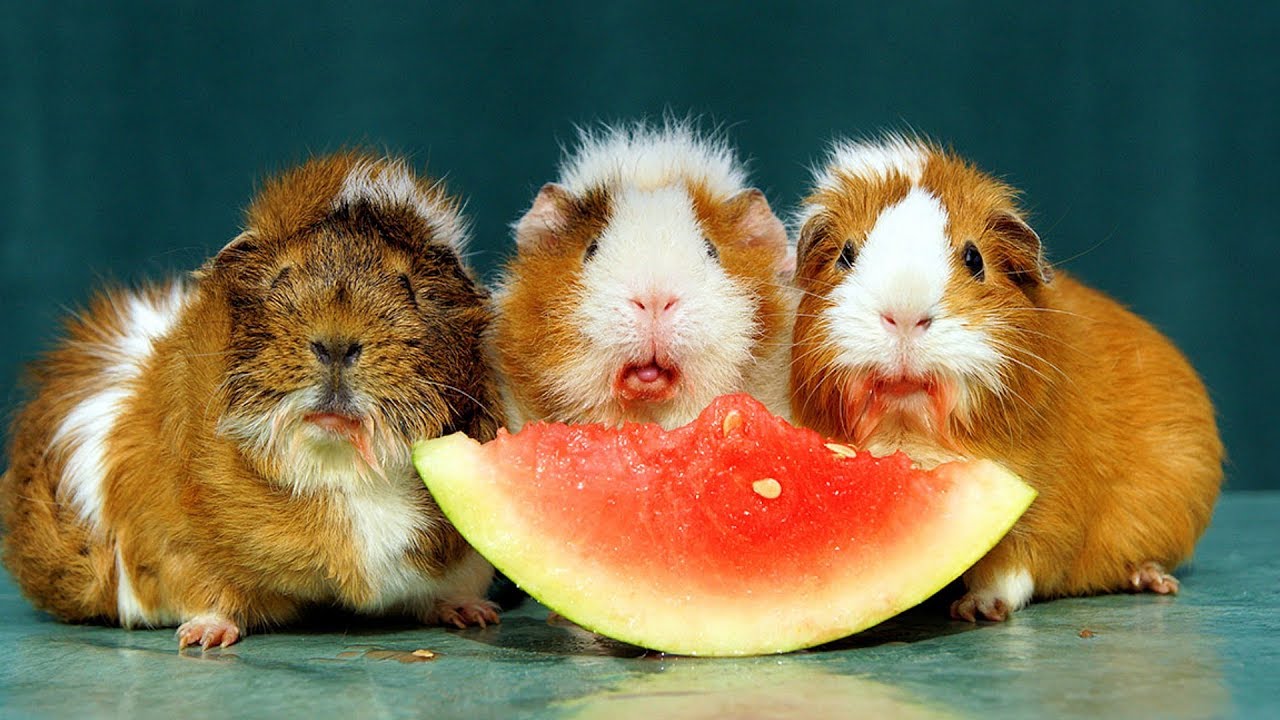What is a guinea pig?
You can find a guinea pig in many everyday households. They are small, furry creatures ranging from around 8 – 10 inches.
Guinea pigs hold aspects similar to the average pig; heads more prominent than their bodies, stout necks and rounded bottoms (with some guinea pigs having no tail at all).
How guinea pigs got called to be “pigs” is not clear. However, even some of their characterises are similar—for example; the sounds they make and the fact that they spend a lot of time eating.
Guinea pigs come in different shapes and sizes. Some guinea pigs are short-haired others long-haired. However, all of them hold a similar characteristic of their ears being small and petal-shaped. Furthermore, their eyes are set on the sides of their heads.
Pet breeds live an average of four to five years but may live as long as eight. According to the 2006 Guinness World Records, the longest living guinea pig survived 14 years, 10.5 months.
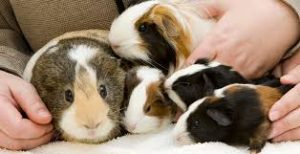
History of guinea pigs
Many may think guinea pigs are native to Guinea. However, they are not. Guinea pigs originated from the Andes of South America. Scientists based in biochemistry suggest guinea pigs never existed in the wild. They were initially domesticated as livestock (for a meat source) and continue to be consumed as food.
Most people see them as fluffy adorable pets, but in Peru guinea pigs – or “cuy” as they are known locally – are a delicacy. In the past few years, their popularity has taken off, and a boom in guinea pig farming is helping many peasant farmers living below the minimum wage to get out of poverty.
Since the 16th century, when guinea pigs were introduced to Europe and North America by European traders in the 16th century. Westerners see the guinea pigs a popular pocket pet.
The domestic guinea pig plays an important role in folk culture for many indigenous Andean peoples, especially as a food source. It is also used in folk medicine and community religious ceremonies.
Though some westerners may view eating the guinea pig as harsh, biological experimentation on domestic guinea pigs has been carried out since the 17th century.
Guinea pigs were used so frequently as model organisms in the 19th and 20th centuries that the epithet guinea pig came into use to describe a human test subject. In modern time this has changed, and they use other rodents, such as mice and rats.
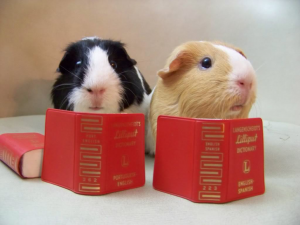
Buying a Guinea Pig
The guinea pigs themselves are inexpensive to purchase, whether you buy them from a shelter or a shop. They usually cost about £20, whichever source you choose but bear in mind that there are lots of guinea pigs without a home in shelters.
Adoption
Blue cross, pets4home and many other charities offer you to adopt guinea pigs that need a new home.
Blue Cross says: “We help find the perfect pet for you by matching the pet to suit you and your family’s lifestyle, ensuring that whatever animal you adopt it is the right one for you.”
Private seller
On the other hand, websites such as gumtree allow people to post private listings of their guinea pig. However, make sure you look carefully as sometimes the owners’ are not looking out for what is best for the guinea pig.
Big shops
If you are looking for something with more guarantee. Pets at home sell guinea pig. They can also provide you with more information. You can also pick up everything you need for your guinea pig (cage, bedding, food) when you are there.
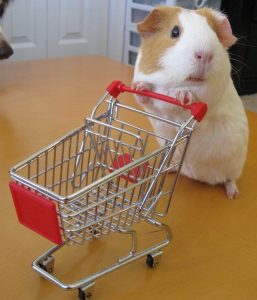
Is a Guinea Pig a good pet?
Guinea pigs are often used as a first pet, of course under the supervision of an adult. However, many also get guinea pigs as adults due to their cute and furry nature.
Guinea pigs also do not get ill quickly; this is an excellent reason for getting one as a pet as you will not need to be spending vast amounts of vet bills.
Thirdly, they are easy to care for. Guinea pigs need a small amount of time dedicated to them each day. They require hay, freshwater, fresh vegetables and a small amount of pelleted food formulated for guinea pigs, plus a vitamin C supplement each day. They also need a reasonably large cage lined with paper-based bedding. The cage needs to be spot-cleaned daily and weekly, completely cleaned. Add some daily attention, and they are good to go.
Guinea pigs hold fantastic personality traits, even though they may all look similar. Some are shy; others are bold and dominant. This is fantastic as you can bond with your guinea pig.
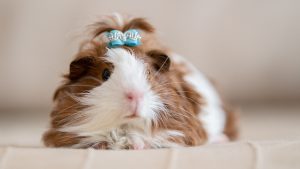
Housing your Guinea Pig.
Overall housing
Guinea pigs need a large hutch, in theory, the bigger, the better, as the guinea pig has more space to roam around. Secondly, make sure it’s weatherproof and with a raise off the ground.
Guinea pigs need a lining in their hutch. A safe and comfy option would be to use clean wood shavings or sawdust. We recommend using any lining, which is dust-free.
Guinea pigs are not consistent sleepers; they will take naps throughout the day. Guinea pigs need the option when to be active, so providing them with aa large, grassy exercise area is ideal.
Making sure your guinea pig is entertained is very important. You can do this by providing them with lots of tunnels and hides in their run so they can move around confidentially and hide if they want to.
Finally, providing your guinea pig with plenty of toys and activities to keep them entertained. Take a look at some helpful youtube videos for how to make your guinea pig toys.
Toys are super simple to make. You can either leave your guinea pig an old cardboard tube. On the other hand, cut a toilet paper tube into ten rings, layer the circles in different directions and fill in the gaps with hay or treats. Another fun game to bring your guinea pig out their shell is threading chopped carrot onto a string. The carrot hung on the line means the guinea pigs have to reach up.
If you are not so keen on making the toys yourself, you can buy them from many shops such as:
Guinea pig market – https://www.guineapigmarket.com/toys
Amazon – https://www.amazon.com/guinea-pig-toys/s?k=guinea+pig+toys
Or why not try and support your local pet shop.
During Summer
Guinea pigs are sensitive to hot weather and can get stressed if the temperature goes above 27°C. In hot weather, move the hutch into a shady area and make sure your guinea pigs have some shade in their run.
During Winter
Protect your guinea pigs from cold winter weather by bringing them indoors. You could also keep them in a warm shed or car-free garage. Give them extra bedding when the weather gets freezing. They’ll need a large indoor exercise area or develop brittle bone disease from not being active enough.
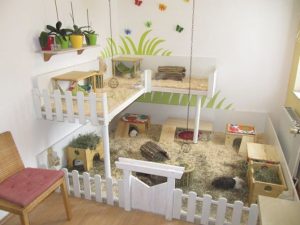
Diet of a Guinea Pig
Guinea pigs don’t usually overeat, but it’s essential to provide the proper balance of pellets, hay and fresh vegetables. Like human beings, guinea pigs cannot make their own vitamin C, so they require vitamin C-rich foods in their daily diet.
Fresh vegetables can be offered once a day and should be equivalent to about one cup total per guinea pig per day. Leafy greens like romaine lettuce, kale, cilantro or parsley should comprise the bulk of your pig’s fresh produce. Vegetables like red or green pepper, broccoli and tomatoes have high vitamin C levels in them and are great daily options. Add carrots, zucchini and sweet potato once or twice a week.
Fruit works well as an occasional treat that is offered once a day or several times a week. Keep the portion size small since fruit is high in sugar; a small wedge of orange or apple, several blueberries or a thin slice of banana is perfectly adequate. Kiwis, strawberries and citrus have high levels of vitamin C.
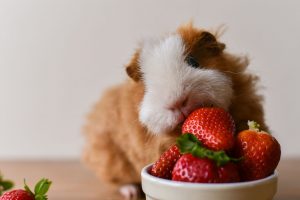
Disease
Guinea pigs are generally hardy, healthy animals but can be prone to problems and diseases.
Pneumonia is one of the most significant diseases of pet guinea pigs. Guinea pigs will have an increased chance of the infection developing if they are young. Signs that your guinea pig is infected is they may be off their food, have discharge from the eyes or nose, sneeze, or have trouble breathing.
Due to guinea pigs (and rabbits) having sensitive bowls, they are more prone to diarrhoea. Other clinical signs that may occur with diarrhoea include anorexia (not eating), depression, dehydration, weight loss, a low body temperature. Guinea pigs with these signs need immediate veterinary attention and supportive care.
Early we spoke about the fact that guinea pigs cannot make their vitamin C; therefore, you must put vitamin C in their diets as an owner. A guinea pig with a rough hair coat is off his food, has diarrhoea, is reluctant to walk, seems painful, has swollen feet or joints, or has haemorrhages and ulcers on its gums or skin, is likely to be deficient in vitamin C.
Most commonly, young guinea pigs are prone to ringworm, which is an infection of the skin with a fungus, not with a worm. Ringworms can happen if the guinea pig is stressed by overcrowding, poor nutrition, the presence of other diseases, or other environmental stresses. The skin affected by ringworm can be itchy, lose hair, and develop crusty scabs. After diagnosis by your veterinarian, affected guinea pigs are treated topically or orally with anti-fungal medications.
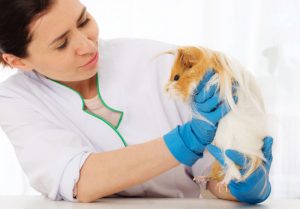
Grooming
There are two types of guinea pigs, one which is long-haired the other short-haired. A long-haired guinea pig will need grooming daily or at least a few times a week. In contrast, a short-haired breed will only require brushing once or twice a week.
Guinea pigs are very good at cleaning themselves, so you shouldn’t overdo it when brushing themselves. Brushing your guinea pig’s hair too much can cause the coat to lose its density.
Your guinea pig will not need bathing (as we mentioned they could bathe themselves pretty well). However, worst comes to worst and need help with cleaning to follow our quick guide (bear in mind the instructions are for long-haired guinea pigs). Short-haired guinea pigs need washing over with a small bit of warm water.
1. Get ready
Fill it up with approximately 2 inches of warm water. Check that the temperature isn’t too hot and that the room is draft-free.
2. Bathing your guinea pig
Slowly lower your guinea pig into the tub, back feet first, and let it rest on the towel. Use a small plastic cup or jug to pour water over its shoulders and back. Do this gently, so you don’t get water all over your guinea pig’s head. Apply a small amount of the shampoo, adding water to work up a lather.
3. Towel dry your guinea pig
Dry your guinea pig with the leftover towels.
Clipping a guinea pig’s nails is considered one of the most intimidating parts of the grooming process, but it isn’t as difficult as you might think. Please have a look at several clips to see exactly how to do it.
At first, grooming might take a little bit longer. But once you get more confident, and your guinea pig gets more comfortable, you’ll be able to get it done quickly and easily.
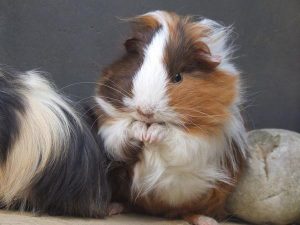
Life Span
Guinea pigs are a long term commitment pet. Though they may not live nearly as long as a cat or dog, they’re still a large time commitment. Guinea pigs live on average around five to seven years, sometimes longer, so be prepared to provide care over the long term.
According to the Guinness Book of World Records, the oldest guinea pig known was 14 years and 10.5 months old and was named Snowball
.
Recognizing when your guinea pig is dying. When the time comes, you can realize the below within your guinea pig.
- Loss of appetite.
- Slow movement or lack of activity.
- Incontinence.
- Less playful behaviour.
- Laboured breathing.
Guinea pigs usually die from pneumonia, or inflammation of the lungs. A bacterial infection usually causes pneumonia in guinea pigs.
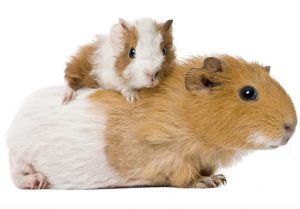
Exercise
Exercising outside the cage is ideal for guinea pigs and provides much more space with a broader range of enrichment opportunities than any cell can offer. Free-range time may be either indoors in a safe room or hallway or arranged outside in a comfortable pen or run.
Take a look at the section above ‘Housing’ for more information.
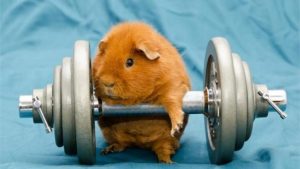
Breeds
Guinea pigs come in different shapes and froms. Overall, there are 13 breeds recognised by the American Cavy Breeders Association (ACBA). However, there are several other guinea pigs exist, which are known for their rarity.
Abyssinian Guinea Pig
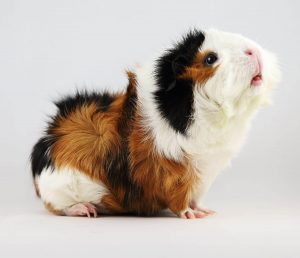
The Abyssinian, for the first-time owner, is an excellent choice because of its extremely affectionate personality. Over the eight-year lifespan, it requires only a bit of training. You can also adopt the Abyssinian Satin breed which has a glossy fur.
Alpaca Guinea Pig
Though the ACBA does not officially recognise this breed, the alpaca is a beautiful breed with wavy, thick hair. It would be best if you considered with this guinea big they need daily brushing and de-tangling (making this guinea pig high maintenance)
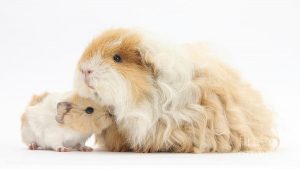
American Guinea Pig
As the most common breed, the American Guinea Pig by default wins the popularity contest. They are known for their excellent temperament and also get along well with other piggies. Its short, smooth coat makes it easy to take off, particularly for children.
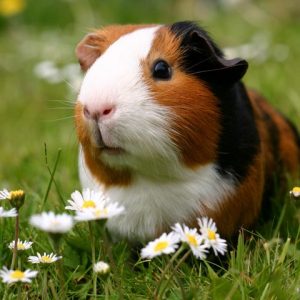
Baldwin Guinea Pig
Baldwin’s appearance is different from the rest. The breed is encouraged to be adopted by individuals who appreciate their unique look. Baldwin’s need extra care such as living indoors, not being exposed to direct sunlight and having a warm blanket nearby at all times.
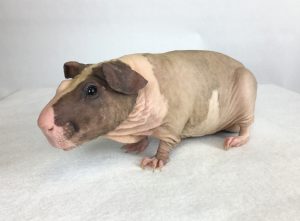
Coronet Guinea Pig
A Coronet has a beautiful flowing, voluminous mane that doesn’t have a part. This sweet ball of fur craves attention and easily attracts it with its curious personality and playful behaviour. If you’re considering adopting one, make sure you set aside time every day to brush its beautiful coat.
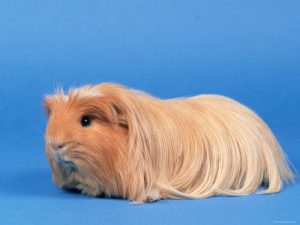
Himalayan Guinea Pig
Himalayans are the Siamese cats of the guinea pig world. This albino breed has a white coat with brown or black colouring on its ears, feet, and nose. We recommend this breed for people who live in a colder climate because, when a Himalayan is put in direct sunlight or hot weather, their dark spots fade. Dark spots fading also happens if the guinea is sick, shocked, or scared. They do best indoors and can live up to seven years.
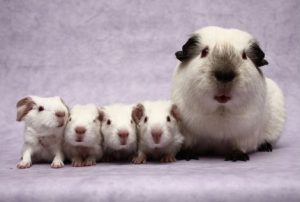
Merino Guinea Pig
Merinos have an affectionate nature and love to explore. Hence, allow your Merino a large cage or even to wander around your house. The Merino guinea pig is an affectionate breed, therefore perfect for families.
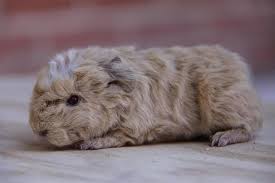
Peruvian Guinea Pig
The Peruvian’s long fur can grow as long as 2 feet! Peruvian’s soft, thick hair needs dedicated grooming time and an occasional trim. The coat also grows forward over its head, giving it a funny-looking fringe. This breed is alert and curious, often greeting visitors who stop by its cage.
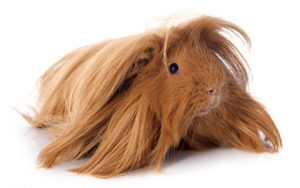
Rex Guinea Pig
The Rex’s short, wool-like fur is a big hit with children. Its floppy ears are a unique feature that makes it look even more lovable. This breed enjoys petting. With those curly whiskers, who could resist!
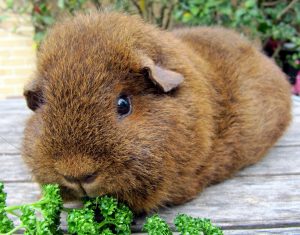
Pregnancy and Babies
The average guinea pig pregnancy lasts 68 days. The shortest range being 59 days and the longest being 72 days. Litter size typically consists of 2-4 pups. A larger litter will result in a more straightforward pregnancy. Continue to encourage exercise & prevent obesity from minimizing the risk of problems in the pregnant period.
If your guinea pig does get pregnant, be sure to keep in contact with your vet and do regular checkups before and after birth.
